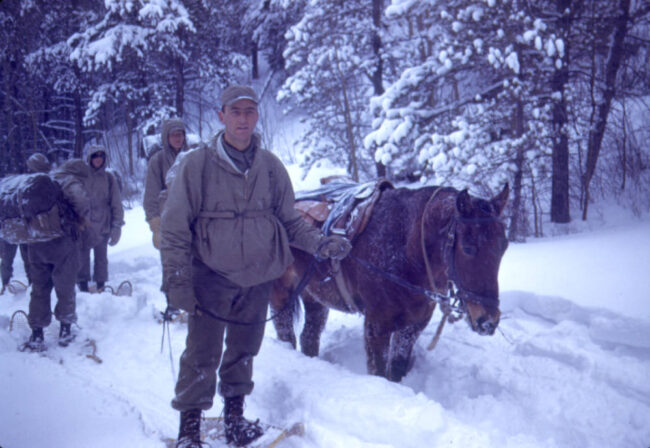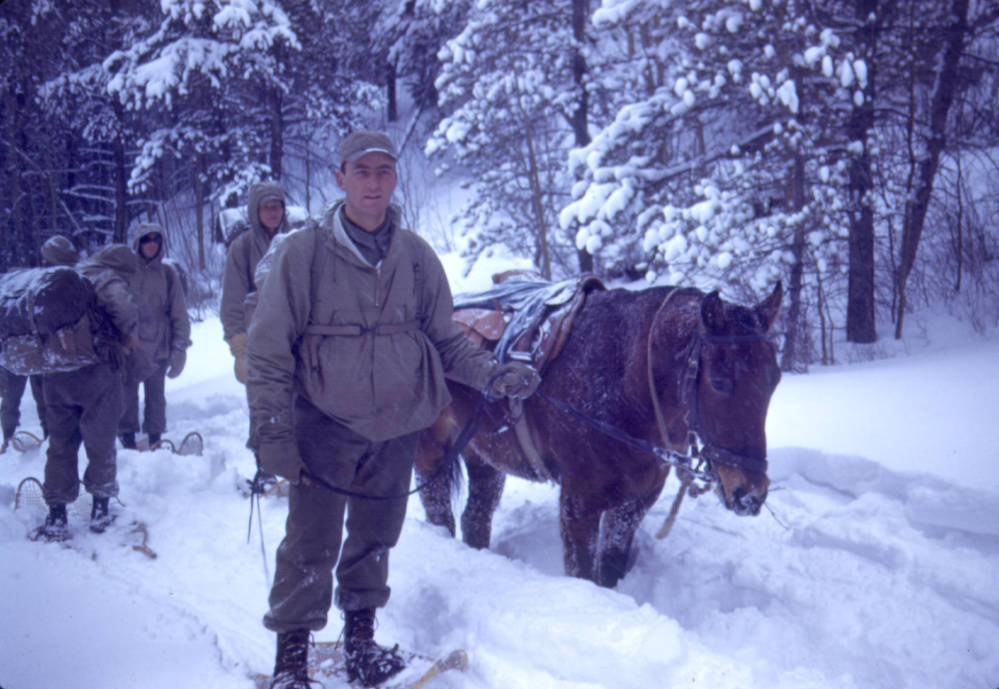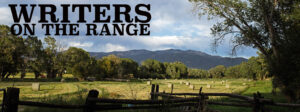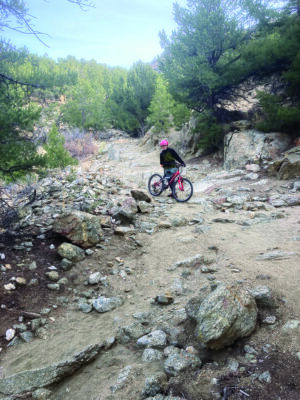
READERS OF THE BUENA VISTA newspaper will occasionally notice that some veteran of World War II is mentioned as having served in the 10th Mountain Division. The distinctive logo for the 10th Mountain appears on the occasional obituary. Sometimes the “winter army” is mentioned in an article.
A few of those men were locals when war broke out, but I have another theory. Some of those soldiers married local women. A soldier probably fell in love with the Upper Arkansas Valley and a local woman at the same time. After the war he settled down around Buena Vista, where his bride had led her young life.
The white-clad 10th Mountain Division, then training at Camp Hale, is a staple of mountain lore. Photos of those men skiing with their rifles and 90-pound packs are still popular in tourist stores. The tale of the winter army is fascinating. It’s best read if you are sitting in a warm room on a blustery January night.
Regular readers of Colorado Central may have journeyed from Leadville to I-70 and looked up at Tennessee Pass. That’s where the railroad crosses under the road. A marker by the railroad for “Pando” still stands there. Originally a little-used stop on the Rio Grande Railroad, Pando had its moment of fame during World War II when that stop became the busy station for the 10th Mountain Division.
The 10th was unique. Later, it was the heart of the force that turned the war around on the southern German-Austrian axis. That action won Italy’s mountains and essentially ended the Nazi rule of Italy.
The story of how a few “lodge skiers” transformed the Tennessee Pass location into the 10th Mountain Division training camp is dramatic. At first, few believed in the whole idea of a mountain winter force backed up by mules and equipped with heavy snow gear. The “naysayers” in the top brass thought fighting in the mountains would never happen. They were wrong. Plenty of fighting took place as the army took the Italian mountains between Dec. 23, 1944, and April 13, 1945.
Those Camp Hale skills and Camp Hale boys were the heart of the Italian campaign. Mountaineering skills were vital when rappelling down and climbing up the walls of Italian mountains. Mountaintop forts like Monte Casino would never have fallen otherwise.
Those assaults often happened in the middle of the night and men were forbidden to speak or drop a piton. When they reached the crack German units, it was hand-to-hand hell. The Mountain Division was melded into the regular army by the time of the famous mountaintop assaults. They did on-the-job training with the newbies. Casualties were huge (at least 1,000) and would have been worse without the 10th.
Those who argued for the mountain division initially envisioned a war much like the winter war Finland was then fighting against the Soviets. They continued to argue that men in the National Ski Patrol were the obvious core for an army division that could do alpine fighting.
Their constant letters to key figures, including President Roosevelt, may have made the difference. I wondered as I read these accounts if the Army establishment was not set up to be deaf to new ideas. The ski patrol regulars constantly emphasized the “initiative and resourcefulness” of their men — the opposite of the Army’s insistence on following orders and making no decisions of one’s own.
The Germans obviously took alpine fighting seriously. Some readers must have been remembering that the German general Rommel got his start leading alpine troops. Hemingway’s famous “A Farewell to Arms” or his “Cross Country Snow” reminds us of the human side of that conflict.
Ski patrollers did have a somewhat strong ally in General Stimson, himself an alpinist. It was rumored that President Roosevelt was in favor of the idea. After all, he had built Timberline Lodge on Mount Hood in Oregon. Still, it was not until after a two-year campaign that the winter division, the 87th, was established in November 1941.
The Army had a couple of experienced men in Lieutenants Woodward and Lafferty. They demonstrated their skills in leading skiers over the mountains to Idaho in 12-foot drifts and blizzard conditions. That won over some. There were experienced men to be found but recruitment came slowly. After a few months, only three men and three mules officially appeared on the mountain troop’s roster.
WHY THE SLOW START? One answer is the mules. Those animals got the troops up the impossible terrain in the Italian campaign. Mules were part of the winning strategy. Each trooper had to have at least basic knowledge of how to pack them. Only a few men learned how to fully convince mules to advance. Those skills took time but did develop.
The leaders of the new mountain division were almost all former ski patrollers and almost all college graduates or students. Seeing early reports about the winter army, I chuckled at a picture of an early platoon leader. What an obvious college boy. His sweater even had a big D on it for Dartmouth. A deep vein of anti-education and anti-college feeling ran through our country. We saw plenty of it again in former President Trump’s campaign two years ago. That anti-intellectualism slowed down acceptance of the mountain division, I think.
On Tennessee Pass today you’ll find a memorial where you can remember the 1,000 men who died after training there. You can park in turnouts and set out for a brief stroll or get out your field glasses to pan the slopes. You might even do a cross-country reconnaissance. A few have spent a night in the Mountain Club hut up there.
I hope some will envision the training that went on there during World War II. Perhaps some will even imagine the 10th Mountain boys with their 90-pound packs and white rifles tied across their chests as they ran, then skied with skins on their skis, then fishtailed, until they needed to rope climb and repel down. Even just remembering it is stirring.
When recruits got off the train in Pando, they probably had little knowledge of the intense experience they were about to have. National publicity certainly did put them in the spotlight. Perhaps that’s part of why “girls” in Buena Vista found them appealing.
Skiers tell me that the Ski Cooper snow up on Tennessee Pass is better for cross-country than downhill skiing: a few big snowdrifts normally lead up to the summit. But the low arroyos in between aren’t much for snow. Who knows what this winter will bring.
We do know that World War II and the 10th Mountain Division influenced the human ecology of the Upper Arkansas Valley. It attracted some of the best and brightest we’ve known. Those women from Buena Vista married well indeed, and they had lucky grooms too.
Forrest has written for Colorado Central since the days when he and Ed Quillen stomped through mosquito swamps following ghost railroads. He lives with his wife Frances in Salida. His show on KHEN 106.9 is called “On the Rails.”




